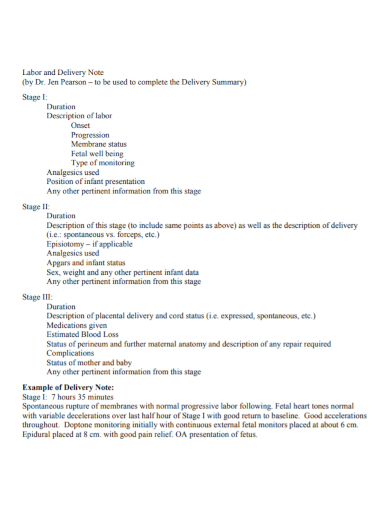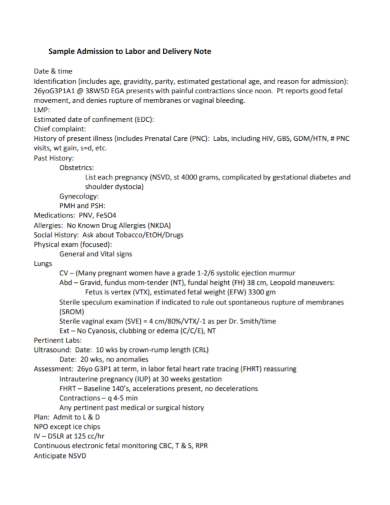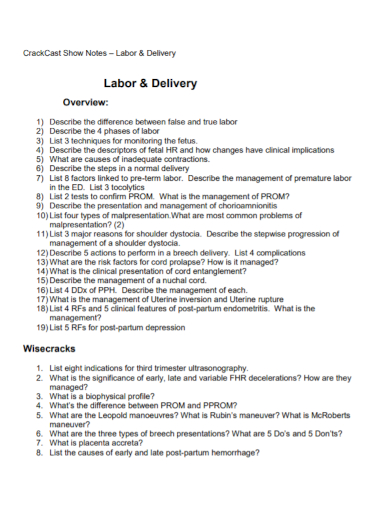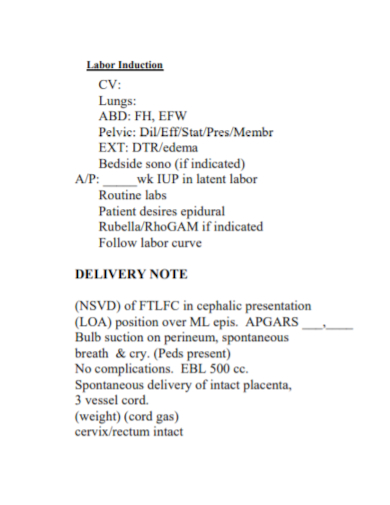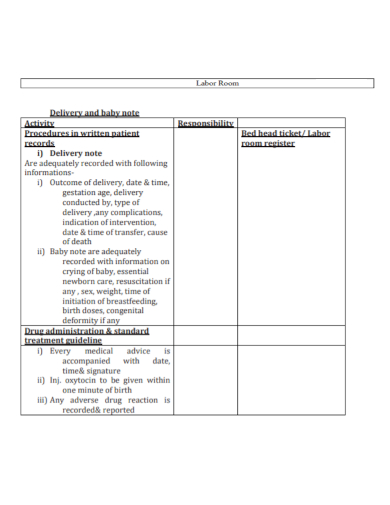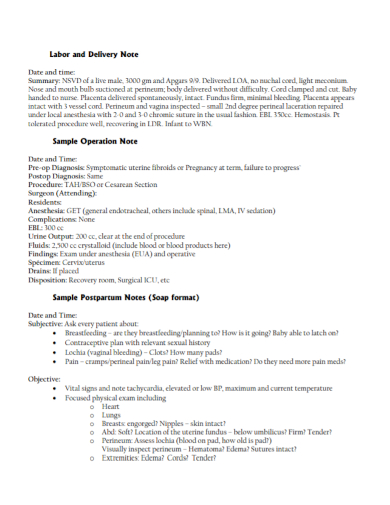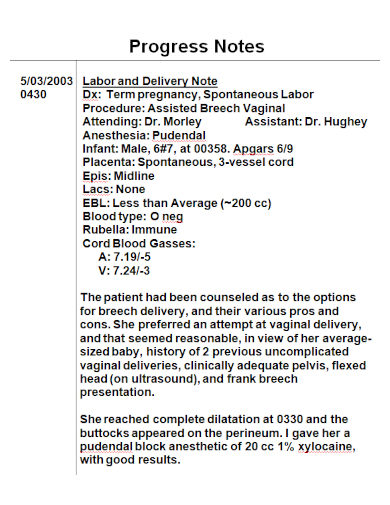Giving birth is one of the most exciting thing that could happen to a woman. And even the most exciting thing that could be for an expecting family. This would be the start or even continuation of a motherhood journey. With the importance of this for personal families, this is also a very passionate job that nurses, doctors and midwives do. While it takes nine months to grow a full-term baby, labor and delivery occurs in a matter of days or even hours. However, it’s the process of labor and delivery that tends to occupy the minds of expectant parents the most. Medical professionals at this moment are the most alert and always holds the responsibility to take note of everything and document every single process. With this being said, labor and delivery notes are needed in the process of giving birth or delivery. To lessen the hassle of doing this from scratch, our site offers you free, available, ready-made and customizable Labor and Delivery Note templates that you can choose. Just browse on this article and choose the template that satisfies your needs the most.
For other note template needs, our site could also offer you templates like Vehicle Delivery Note, Company Delivery Note, Service Delivery Note, Goods Delivery Note, New Delivery Note, Car Sale Delivery Note, Return To Work Doctor’s Note, Doctor’s Excuse Note, Material Delivery Note, Intake Progress Note, and more in the store just for you. Our article does not only offer you essential templates that could help you but also with necessary details and information that you need to know for your project. So come on, read the rest of the article with me!
6+ Labor and Delivery Note Samples
1. Labor and Delivery Note
2. Admission Labor and Delivery Note
3. Sample Labor and Delivery Note
4. Labor Induction Delivery Note
5. Labor Room and Baby Delivery Note
6. Labor and Delivery Operation Note
7. Labor and Delivery Progress Note
Labor And Its Signs
Labor has started or is coming soon if you experience symptoms such as:
- increased pressure in the uterus
- a change of energy levels
- a bloody mucus discharge
Real labor has most likely arrived when contractions become regular and are painful.
First Stage Of Labor
Labor and delivery are divided into three stages. The first stage of labor incorporates the onset of labor through the complete dilation of the cervix. This stage is further subdivided into three stages.
Early Labor
This is normally the longest and least intense phase of labor. Early labor is also called the latent phase of labor. This period includes the thinning of the cervix and dilation of the cervix to 3-4 cm. It can occur over several days, weeks, or just a few short hours.
Contractions vary during this phase and can range from mild to strong, occurring at regular or irregular intervals. Other symptoms during this phase can include backache, cramps, and a bloody mucus discharge.
Most women will be ready to go to the hospital at the end of early labor. However, many women will arrive at the hospital or birthing center when they are still in early labor.
Active Labor
The next phase of the first stage of labor occurs as the cervix dilates from 3-4 cm to 7 cm. Contractions become stronger and other symptoms may include backache and blood.
Transitional Labor
This is the most intense phase of labor with a sharp increase in contractions. They become strong and occur about two to three minutes apart, and average 60 to 90 seconds. The last 3 cm of dilation usually occur in a very short period of time.
Second Stage Of Labor
Delivery
During the second stage, the cervix is fully dilated. Some women may feel the urge to push right away or soon after they’re fully dilated. The baby may still be high up in the pelvis for other women. It may take some time for the baby to descend with the contractions so that it’s low enough for the mother to start pushing. Women who don’t have an epidural typically have an overwhelming urge to push, or they have significant rectal pressure when the baby is low enough in the pelvis. Women with an epidural may still have an urge to push and they may feel rectal pressure, although typically not as intensely. Burning or stinging in the vagina as the baby’s head crowns is also common.
It’s important to try to stay relaxed and rest between contractions. This is when your labor coach or doula can be very helpful.
Third Stage Of Labor
Delivery Of Placenta
The placenta will be delivered after the baby has been born. Mild contractions will help separate the placenta from the uterine wall and move it down towards the vagina. Stitching to mend a tear or surgical cut (episiotomy) will occur after the placenta is delivered.
FAQs
What is called delivery of baby?
Birth, also called childbirth or parturition, process of bringing forth a child from the uterus, or womb.
What is normal delivery of a baby?
In the broadest definition, normal childbirth includes a labour that begins spontaneously, usually between 37 and 42 weeks of pregnancy. Normal birth also includes skin-to-skin holding after delivery, and breastfeeding within the first hour after delivery.
You might find yourself getting caught up in the report that you are making especially that you’ve got to do it from the very scratch. With this, it is highly encouraged of you to make available all the resources you can find online. What are you waiting for? Avail our templates in SampleTemplates now!
Related Posts
FREE 11+ Sample Discharge Summary
FREE 10+ Sample Material Request Forms
FREE 10+ Distribution Report Samples
FREE 9+ Agreement Between Two Parties For Money Samples
FREE 8+ Sample Payment Received Receipt Letter
FREE 6+ Sample Commitment Letter
FREE 3+ Artist Management Agreement Samples
FREE 23+ Requisition Letter Samples
FREE 12+ Job Schedule Samples
FREE 10+ Equipment Invoice Samples
FREE 8+ Sample Employee Declaration Forms
FREE 8+ Sample Employee Clearance Forms
FREE 8+ Anesthesiologist Job Descriptions
FREE 4+ Child Custody Form Samples
Simple Agreement

